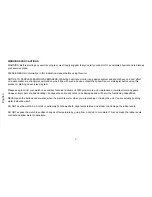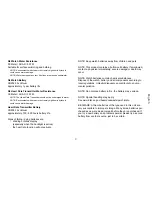
12
English
trouBLEsHootiNg tHE HEart ratE traNsMittEr
Ensure proper placement and alignment of transmitter on chest
If you are not getting a good connection, you may be wearing the transmitter too high or too low on the chest.
Adjust the position on the chest to see if the connection changes to satisfactory results. You may be experiencing issues
with connection due interference with workout shirts, under garments or sports bras. Ensure that the transmitter is 100%
in contact with the skin and not on top of any clothing.
cross-talk
Exercising in close proximity to other people using heart rate monitors may cause your watch to pick up signals from chest straps
other than your own. This is known as Cross-talk. To avoid problems associated with Cross-talk it is recommended that you separate
yourself from others wearing heart rate monitors by a minimum of 3 feet or 1 meter in all directions.
transmission range
The heart rate monitor system has an effective range of 28 - 30 inches ( .75 meters ). If the monitor is separated from the transmitter
strap by a greater distance than this, you may not be able to receive a heart rate signal.
avoiding Environmental interference with the Heart rate transmitter.
Analog heart rate monitors function using a very low transmission frequency. Because of this they are susceptible to interference from
a variety of electromagnetic and microwave sources. High-tension power line, traffic light controls, home and automotive electronics,
powered exercise equipment; home security and wireless LAN systems and other things may interfere with the ability of the system to
register a heart rate.
Intermittent readings of zero or of very high heart rates ( exceeding 210 beats ) are an indication of some type of interference.
In general, the interference caused by these sources is localized. After a few seconds or at most minutes,
you should pass from the area of interference and the operation of the watch should return to normal.
































